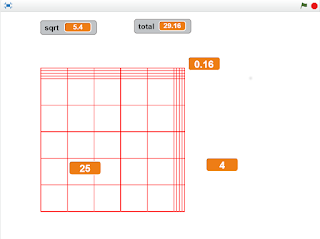After such a long break I though I will start with something simple. A couple of questions from children. A couple of weeks back one child said 15 does not have a square root (only 16 does and that is 4). I wondered what kind of creatures children thought surds are. I had done some square root work with 10 graders using graphs and it seemed to give them some idea that these are also numbers of some sort a month back, but it was a passing comment and I let it go.
Recently, a volunteer started coming into STEM Land and I asked him as I ask all adults to work on some projects to inspire children. I suggested creating some sort of graph in scratch for children to see the squares of non-whole numbers. He started it and got as far as creating squares for whole numbers (similar to what the 7th graders with Sundar did last year) and then gave up, preferring to use his time more productively by finding children who wanted to be taught.
Anyway, another week went by and I decided to take up this project and made a rudimentary squaring version with visual boxes (my hope is always to make something functional, but so terrible that anyone who sees it will want to modify it :-)). I went in yesterday and showed it to the volunteer. One child came by and asked what we were up to (never underestimate the curiosity of a child), I showed him, then another, then another kid. They played with it for some time. Then I modified the program to calculate a square root. This seemed to garner a little more interest. They started playing with the program and one of the 10th graders had an activity class and connected it to the graphs he had drawn and started explaining it to the younger kids. My work was done and I walked off leaving the computer to them.
Towards the later half of the session one girl came to me and asked me what the square root of 60 was. I walked her through my guess and she concurred, but murmered something about off screen. A little later she came back and asked me what the square root of 0.05 was. Hey where did that come from? She explained that she was tying to figure out how small a figure she can get and saw the really small square of just 4 of 1/100 and she triggered the software by asking it to calculate the closest square to 0.05.
I went back and put 60 into the program and realized she was testing where the program ran out of space to fill the boxes. Boundary conditions, interesting...
[Thanks Swathi for suggesting graph notebooks and that areas up to 2 decimal places can naturally be represented in a graph notebook.]
Boring digression from the story:
If we look at a regular graph sheet it is divided into large 1 cm squares. Within these the squares are split vertically 1 mm lines and horizontally in 1 mm thin lines. There are also helpful guide lines at 5 mm that are a little thicker than the 1 mm lines. These lines divide a single square into 10 vertical pieces (0.1) and 10 horizontal pieces (0.1) and together into 100 smaller 1mm^2 squares. The big square is whole and a smaller square is 0.01.
Here is a picture:
Children are comfortable with decimal numbers on the scale. They can easily mark out 5.4 cm on the graph paper and soon realize that its 5 dark lines and 4 light lines.
If we marked 5 cm in both x and y axis and completed the square we will get 25 full squares. No surprise, area is multiplication.
The same happens if we mark 5.4 cm in both x and y axis. What is the area of this? The following image may be a helpful... 25 big squares (=25), 4 rods x 5 (4x0.1x5 = 2) vertical and same horizontal (=2) and 4x4 (1/100) (=0.16).
Now playing with modified program of a square root.
Here are the programs to play, break and make something better!
Squaring program : https://scratch.mit.edu/projects/115474246/
Square root program: https://scratch.mit.edu/projects/115470991/


1 comment:
very nice post written by admin.
Thanks,
Crude Oil HNI Calls
Post a Comment